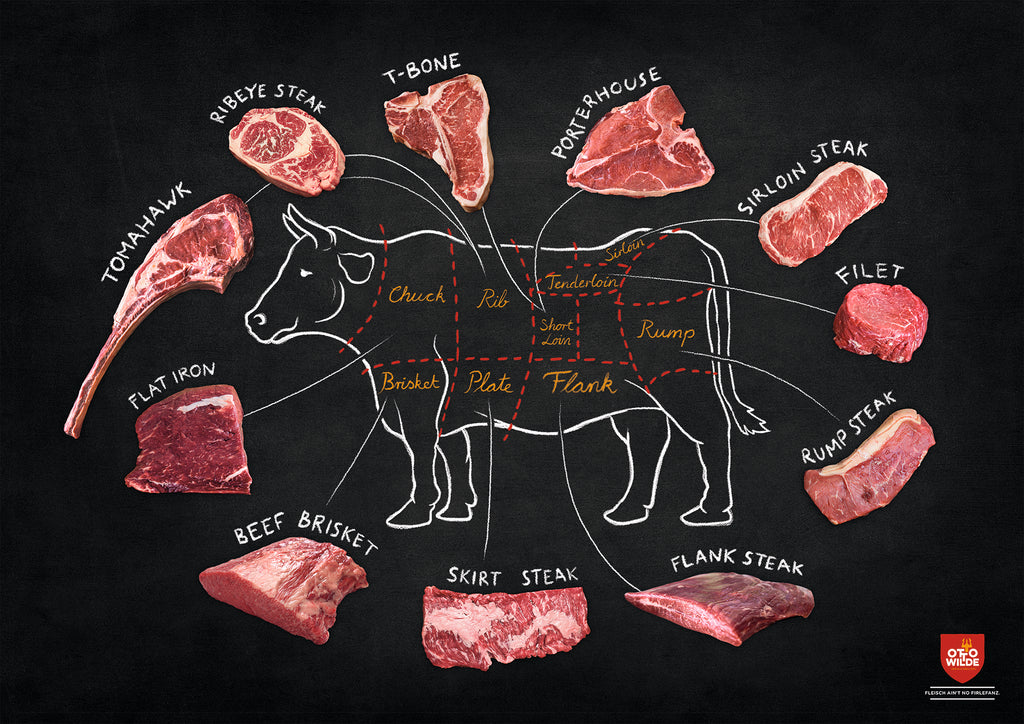Do you find yourself torn between two mouthwatering steak options on the menu? The eternal dilemma between flank and flat iron steak continues to baffle meat enthusiasts worldwide. Don’t worry, we’ve got the facts to help you navigate this delicious steak showdown.
Let’s uncover the characteristics, flavors, and tenderness of these two beefy contenders to help you make the perfect choice for your next steak indulgence. So, grab your knife and fork as we dive into the flavorful world of Flank vs Flat Iron Steak.
Flank Steak: Flavorful and Versatile

Flank steak is a cut of beef prized for its intense beefy flavor and leanness. It comes from the cow’s lower abdomen and has long, flat muscle fibers. This makes flank steak a versatile option for many dishes.
Cooking Flank Steak
Flank steak can be prepared in several ways, each bringing out its unique qualities. Grilling is a popular choice, infusing the steak with a smoky char while keeping it juicy and tender. Broiling offers another option, creating a caramelized crust on the outside while maintaining the desired doneness inside. For a quick and flavorful meal, stir-frying is a great way to cook flank steak. This allows it to absorb the delicious flavors of the sauce and vegetables.
Tenderizing Tips
While naturally lean, flank steak can be a bit chewy due to its long muscle fibers. To achieve maximum tenderness, there are two key things to remember: marinating and slicing. Marinating helps break down the muscle fibers, resulting in a more tender texture. Additionally, always slice the cooked flank steak against the grain. This cuts across the muscle fibers, making them shorter and easier to chew.
Flank Steak Dishes
With its bold flavor and unique texture, flank steak shines in various dishes. It’s a popular choice for fajitas and stir-fries, where it readily absorbs the flavors of the accompanying ingredients. Flank steak can also be enjoyed on its own as a flavorful steak, especially when prepared with care.
Flat Iron Steak: A Tender and Flavorful Choice
The flat iron steak, also known as a butler’s steak, has become a popular cut for its tenderness and rich flavor. This delicious steak comes from the chuck, or shoulder, of the cow, specifically the top blade muscle.
Rich Flavor and Versatility
The flat iron is well-marbled, with thin streaks of fat running throughout the muscle. This marbling is what makes the steak so juicy and flavorful. Flat iron steaks are also known for their versatility. They can be grilled, broiled, or pan-seared, making them a great option for a variety of meals.
What Makes it Special?
The flat iron steak has a unique triangular shape, similar to an old-fashioned flat iron. But the real star of the show is the marbling, which not only adds flavor but also contributes to the steak’s tenderness. Every bite is a melt-in-your-mouth experience.
Cooking Flat Iron Steak
To get the most out of your flat iron steak, there are a few key cooking methods to consider. Grilling is a popular choice, as it sears the outside of the steak and locks in the juices. Pan-searing in a hot skillet with a little oil is another option, creating a delicious crust. Broiling, which involves cooking the steak under high heat in the oven, is another way to cook flat iron steak. Regardless of the method you choose, for the best results, aim for a medium-rare cook.
Flank Steak Flavor And Texture
Flank steak is a flavorful cut of beef known for its bold, beefy taste. It’s lean and dense, with long muscle fibers that can make it chewy if not cooked properly.
Unlocking Tenderness:
Marinating is key to ensuring a tender flank steak. Marinades contain acidic ingredients like vinegar or citrus juice, which help break down the muscle fibers, resulting in a juicier and more tender steak.
Cooking for Perfection:
For the best results, aim for a medium-rare or medium doneness. Once cooked, slice the flank steak thinly against the grain. This means cutting across the muscle fibers, creating bite-sized pieces that practically melt in your mouth.
Searing vs. Marinating: Choosing Your Method
There are two main approaches to preparing flank steak: searing and marinating.
- Searing: This method involves cooking the steak quickly over high heat. It creates a delicious crust on the outside while keeping the inside juicy. Searing is a great option for those who prefer a simple and quick cooking method.
- Marinating: Soaking the flank steak in a flavorful marinade adds depth and complexity to the taste. Choose a marinade with herbs, spices, and acidic liquids. This approach is ideal for those who want a more flavorful steak.
Ultimately, the choice between searing and marinating depends on your preference and desired outcome.
Flat Iron Steak: A Flavorful and Tender Cut

Rich Flavor and Melt-in-Your-Mouth Tenderness
Flat iron steak is a favorite among steak lovers for a reason. It boasts a rich, beefy flavor that’s both juicy and succulent. This deliciousness comes from the fine marbling throughout the meat, which creates a tender texture that practically melts in your mouth. No matter how you cook it, grilled or pan-seared, the flat iron steak remains exceptionally juicy, making for a truly satisfying meal.
Flavorful and Versatile
The perfect balance of flavor and juiciness makes flat iron steak a versatile choice for various cooking methods and recipes. You can explore different flavor profiles while still enjoying the inherent deliciousness of this cut.
Grilling vs. Pan-Searing: Two Delicious Options
There are two main ways to cook a flat iron steak: grilling and pan-searing. Each method offers its own benefits:
- Grilling: This method adds a smoky flavor and creates beautiful grill marks. Preheat your grill to high heat and cook the steak for 5-6 minutes per side for a medium-rare finish.
- Pan-Searing: This method delivers a delicious crust on the outside while keeping the inside juicy and tender. Heat a skillet over high heat, add oil, and sear the steak for 3-4 minutes per side. This option is perfect if you don’t have a grill or prefer faster stovetop cooking.
Both grilling and pan-searing will bring out the flat iron steak’s natural flavor, resulting in a delicious and satisfying meal. The best method depends on your preference and available equipment. Whichever method you choose, remember to let the steak rest before slicing to lock in the juices and flavor.
Flank Steak vs. Flat Iron Steak: Nutrition
Are you deciding between flank steak and flat iron steak? Here’s a breakdown of their nutritional content to help you decide.
- Flank Steak: This lean cut boasts lower fat and calorie content. It’s also a great source of protein and essential nutrients like iron and vitamin B12.
- Flat Iron Steak: Slightly higher in fat, flat iron offers a richer flavor. Like flank steak, it’s rich in protein and contains similar nutrients.
Both steaks can be part of a healthy diet. When making your choice, consider your preferences and dietary needs.
Health Benefits and Considerations
Flank and flat iron steaks offer several benefits:
- Protein Powerhouse: They’re excellent sources of protein, crucial for building and repairing muscle.
- Nutrient Rich: Both cuts contain iron and vitamin B12, which are important for healthy blood cells and nerves.
Remember these points when enjoying steak:
- Cooking Method: Grilling or broiling can create harmful compounds. Avoid charring the meat.
- Moderation is Key: Excessive red meat intake may increase the risk of heart disease. Aim for a balanced diet with various protein sources.
Flank Steak vs Flat Iron Steak: Choosing the Perfect Cut
Flank steak and flat iron steak are delicious options, but they each have unique qualities that make them better suited for certain dishes. Let’s explore the key differences and similarities to help you pick the perfect steak for your next culinary adventure.
Flavor and Texture: A Tale of Two Steaks
- Flank Steak: This cut boasts a bold, beefy flavor. However, it’s on the leaner side and not naturally as tender.
- Flat Iron Steak: Exceptionally tender with rich flavor thanks to its beautiful marbling.
Cooking Up a Treat: Methods for Each Steak
Both cuts can be grilled or pan-seared. Flank steak, however, benefits greatly from marinating to improve tenderness and flavor.
Nutritional Value: A Powerhouse of Protein
Flank and flat iron steak are both excellent sources of protein and essential nutrients.
Choosing Your Steak Champion
Consider the desired taste and cooking method when making your decision:
- Flank Steak: Ideal for dishes that crave its bold flavors, like fajitas and stir-fries. Marinating is a must.
- Flat Iron Steak: Perfect for recipes that prioritize tenderness, like grilled steaks or salads.
Recipe Inspiration: Flavorful Steak Ideas
There’s a world of flavor waiting to be explored with flank and flat iron steak. Here are a few recipe ideas to spark your creativity:
- Grilled Flank Steak with Chimichurri Sauce: Marinated flank steak served with a vibrant chimichurri sauce for a delightful combination.
- Flat Iron Steak Stir-Fry: Thinly sliced steak stir-fried with vegetables and a savory sauce for a quick and flavorful meal.
- Flank Steak Tacos: Marinated flank steak served in warm tortillas with your favorite toppings – a crowd-pleasing fiesta!
- Flat Iron Steak Salad: Sliced steak on a bed of greens with a tangy balsamic vinaigrette for a satisfying and light lunch.
The Secret to Steak Perfection: Let it Rest
Always remember to let your steak rest for a few minutes before slicing. This allows the juices to redistribute throughout the meat, resulting in a more tender and flavorful experience.
With these tips and recipe ideas, you’re well on your way to creating delicious and impressive steak dishes for any occasion. Happy cooking!
References:
FAQ About Steak Showdown: Flank Vs Flat Iron Steak
Q: What is the main difference between flank and flat iron steak?
A: The main difference lies in the location of the cut on the cow. Flank steak comes from the abdominal muscle, while flat iron steak is cut from the shoulder area.
Q: Which steak is more tender, flank or flat iron?
A: Flat iron steak is usually considered more tender than flank steak due to its finer grain and marbling.
Q: How should flank and flat iron steak be cooked?
A: Flank steak is best cooked quickly over high heat to rare or medium-rare doneness, while flat iron steak, due to its tenderness, can be cooked to medium doneness.
Q: Can both flank and flat iron steak be used for grilling?
A: Yes, both cuts are great for grilling but require different cooking times and techniques. Flank steak benefits from a quick sear, while flat iron steak can be cooked more slowly to preserve its juiciness.
Q: Are flank and flat iron steaks suitable for marination?
A: Flank steak is excellent for marination to add flavor and tenderize the meat, while flat iron steak can also benefit from a shorter marination time to enhance its already juicy nature.
Q: Which cut is more cost-effective, flank or flat iron steak?
A: Flank steak is generally more budget-friendly compared to flat iron steak, making it a popular choice for those looking for a delicious yet affordable steak option.
Q: Can flank and flat iron steak be used interchangeably in recipes?
A: While both cuts can be delicious, they have different textures and flavors. For the best results, choose the cut that matches the recipe’s cooking method and flavor profile.

The Finer Diner has a rich history deeply rooted in the Mt. Oliver and Hilltop community. Our journey began with a simple yet ambitious vision – to create a welcoming space where friends and families could come together to enjoy delicious, comforting meals in a classic diner-style setting. Since our establishment, we have been dedicated to serving food, creating lasting memories, and fostering a sense of belonging within our community. Our commitment to quality, authenticity, and exceptional service has been the cornerstone of our success.